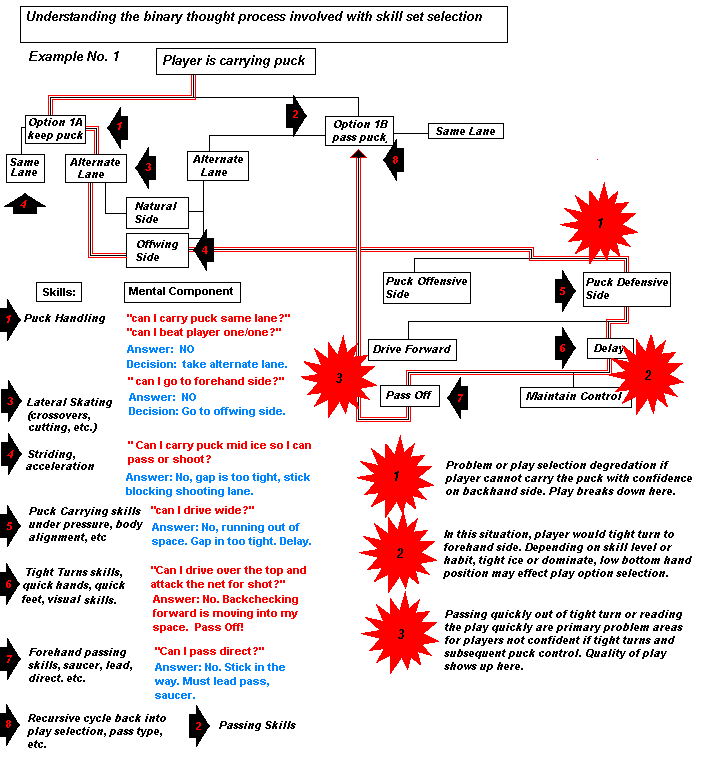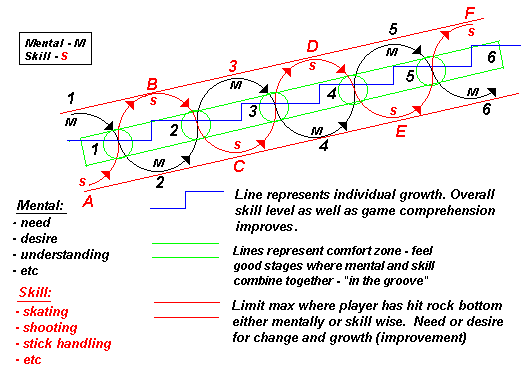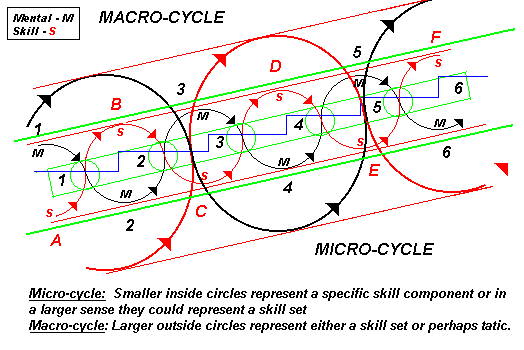
BINARY AND LINEAR THOUGHT PROCESSES
What we must understand is the mental skill set and/or tactical sequencing that takes place. Decisions should follow a natural progression with simple steps (decisions). These decisions should follow a simple "left or right", "forward or backward" mentality. This allows the primary to move through options in a very quick, fluid manner. The example shown below may take only a few seconds depending on opposition pressure.
Diagram No. 14

The following diagram provides a more in depth explanation of the decision making process. In this example we will assume that the player has decided to carry the puck. Each decision has two distinct alternate variables as shown by black arrows. In option 1, the primary has moved into a situation where the opposition has limited his space and forced him to make a decision.
Diagram No. 15

As we can see, proper training both from a negative (what bad thing would happen if I chose an alternate decision) as well as from a positive (what good thing would happen if I chose an alternate decision) point of view is absolutely critical. A player must understand both variables in order to make quality decisions. This mental - skill relationship is a process that cycles back and forth in a dominate role over a player's hockey career. By dominate I mean that one drives the learning or motivation to improve the other. In the beginning of a player's hockey career, the mental cycle is obviously high; "I want to learn how to skate, puck-handle and shoot". This creates the passion for learning the skills of the game. As the skills improve they gradually become the dominate force, driving the mental to learn the game in the tactical sense. "I can skate, shoot and pass but I do not know how to do a 2 on 1 correctly". This cycle moves back and forth. Once a player acquires a new set of skills he must be taught where to use them. Once a player understands more of the tactical side of the game, he knows what areas relative to skill he must improve. This cycle is shown below.
Diagram No. 16 Mental / Skill Cycle Analysis

This cycling creates highs and lows in a players career. It then becomes important to understand when a "high" is happening and take advantage of it (when a player is playing "in the groove"). These highs are demonstrated in the cycle as the green circles in the middle. This is where both mental and skill integrate perfectly. The lows are depicted by the red lines running parallel. This would represent a player "slumping" (hasn't scored in ten games, etc.). These cycles are evident in all areas of play' gross or fine, micro or macro. The following diagram represents this cycling overlap.
Diagram No. 17 - Cycle Integration Analysis

This rotating cycle can be best described using the following example. Lets assume that the micro-cycle is passing skills and the macro-cycle is tactical two on ones. The micro-cycle "mental" component is the need to pass better (1M), the larger macro-cycle is wanting to learn how to perform two on ones properly. Passing skill is low and macro-skill execution (skating, carrying puck and passing) is weak. Player learns how to pass forehand side and understands first rule of 2 on 1 engagement thus the cycles merge and integrate properly at (3C). As an extension of learning how to pass the player learns how to backhand pass better as well as saucer pass. Skills are high but mental execution is weak. New rules of engagement are learned, new cycle develops and merges in next macro - cycle rotation past (F6). There can be many over- lapping cycles involving large team "gross tactical" systems, "fine tactical" systems involving 1, 2 or 3 players, skills, skill-sets or even career cycles. How all of these systems integrate and support each other is absolutely critical to maximizing a player's development.
My C.A.T. System of development is based on the above fundamentals. A hockey player cannot be "created" overnight. A system of analysis and correction is paramount to creating a developmental "road map" that a player can follow for the next 5 to 6 years and in cases of fine tuning fundamentals and tactics, many more years are required.